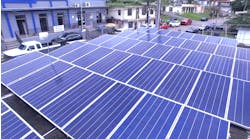Six tribal microgrids will be built on Native American lands via a $39 million investment from the tribes and federal Indian energy funds.
The microgrids — four “shovel-ready” microgrids for communities and two for facilities — are part of 14 tribal energy infrastructure projects awarded money via the US Department of Energy’s Office of Indian Energy Funding Opportunity Announcement (FOA).
“The selected projects are consistent with the principles of tribal sovereignty and self-determination, with a fuel- and technology- neutral energy strategy that recognizes the breadth of energy resources on tribal lands, and each tribe’s right to use them as they see fit,” said Kevin Frost, director of the Office of Indian Energy. “Combined, these projects add up to over 13 MW of installed generation that will impact over 900 tribal buildings, with combined annual savings of approximately $7.5 million — significant investments that will yield tangible results to improve the quality of life for these communities.”
Located in Alaska, California and Wisconsin, the tribal communities are pitching in some $23 million in cost sharing, with the remainder from the grants. The tribal microgrids will allow the reservations to reduce use of utility grid power, improve energy reliability and resilience, lower carbon output and reduce energy costs.
Data on the 6 tribal microgrids
California’s Rincon Band of Luiseño Indians plans to use $7.3 million of grant funding and contribute $5.3 million to build two microgrids on the Rincon Indian Reservation in Valley Center.
Together, the two tribal microgrids will incorporate about 3,100 kW of solar PV, 2,450 kW of battery energy storage and 2,920 kW of standby, diesel generation, enough to serve a large portion of the tribe’s essential facilities and services, including fire protection, emergency management, public shelter, fuel supplies, and water and wastewater treatment systems. Each will be able to run independently of the grid during outages. They are expected to save the tribe $500,000 per year and more than $9.2 million over 25 years.
Awarded $2.3 million in federal energy funds and kicking in another $1.1 million, California’s Colusa Indian Community Economic Development Corporation will develop a 448-kW solar parking lot canopy system and interconnect to a medium-voltage microgrid system that serves 10 tribal buildings. The on-site PV will offset more expensive electricity from existing sources. Savings over the projected life of the project are expected to total more than $5.6 million. Use of the solar will reduce the need for generation from the existing microgrid system by 6.6%.
Alaska’s Igiugig Village Council won $3.3 million in grants and proposed to pitch in $1.5 million for a microgrid based on a 35-kW, run-of-river marine renewable energy generator, smart microgrid electronics and battery energy storage. The microgrid will have the capacity to power the tribal village’s facilities autonomously. Its expected to displace about 11,000 gallons of diesel used to generate power. Anticipated cost savings are between $68,000 and $88,000 over 20 years.
Track news about tribal microgrids. Subscribe to the free Microgrid Knowledge newsletter.
Nuvista Kwethluk Energy Storage of Anchorage, Alaska will use $892,562 of grants and contribute $446,281 to install a 500-kW/670-kWh battery energy storage system and integrate it into the Kwethluk hybrid wind-diesel microgrid. When fully charged, the battery will be able to generate more than 500 kW of power for more than 1 hour to meet peak loads for the entire community, or enough electricity to provide emergency power at the current average community load of 180 kW for more than 2.5 hours. The battery is expected to save about $68,000 annually and $1.17 million over the system’s life.
In addition, the Office of Indian Energy awarded just shy of $2 million for two solar-and-storage microgrids to the Bad River Band of the Lake Superior Tribe of Chippewa Indians in Odanah, Wisconsin. Bad River Band will kick in nearly $1 million. The microgrids are designed to meet 100% of the two buildings’ electricity needs, reducing electric bills by about $841,000 over 25 years. Enhancing energy resiliency and reliability, the two tribal microgrids include smart controls and energy management features and will allow them to operate autonomously when the utility grid goes down.
First for Office of Indian Energy
The grants emerged from the first fuel and technology-neutral funding opportunities by the Office of Indian Energy “that also specifically sought energy system or systems for autonomous operation to power essential tribal facilities or for community resiliency, microgrids,” said Lizana Pierce, deployment supervisor at the DOE Office of Indian Energy.
“Applications in response to these FOAs are for deployment-ready systems — systems that are ready to install — which means typically that a great deal of time and money has been invested prior to completing the application. Those requirements generally limit the number of applications received,” Pierce said in an interview with Microgrid Knowledge.







